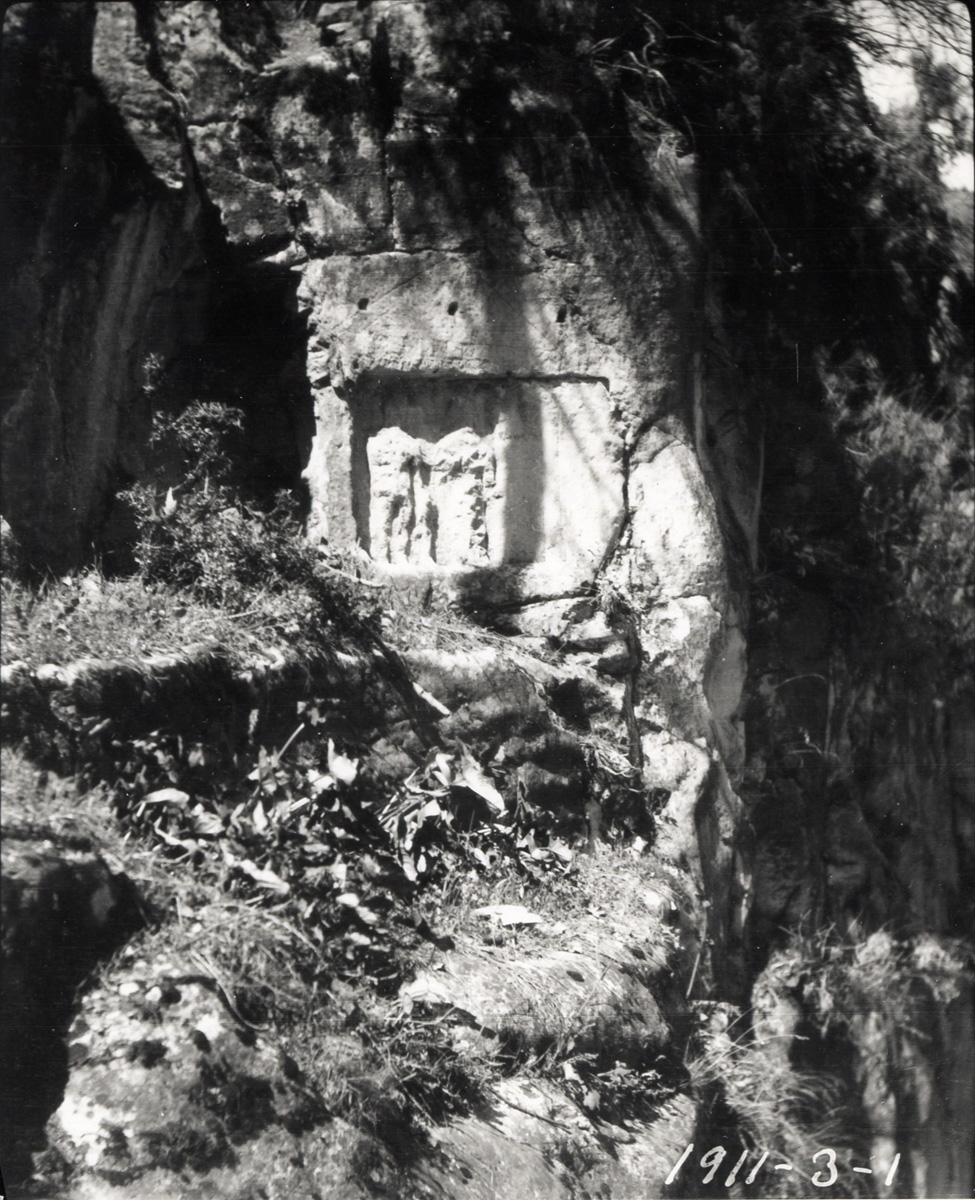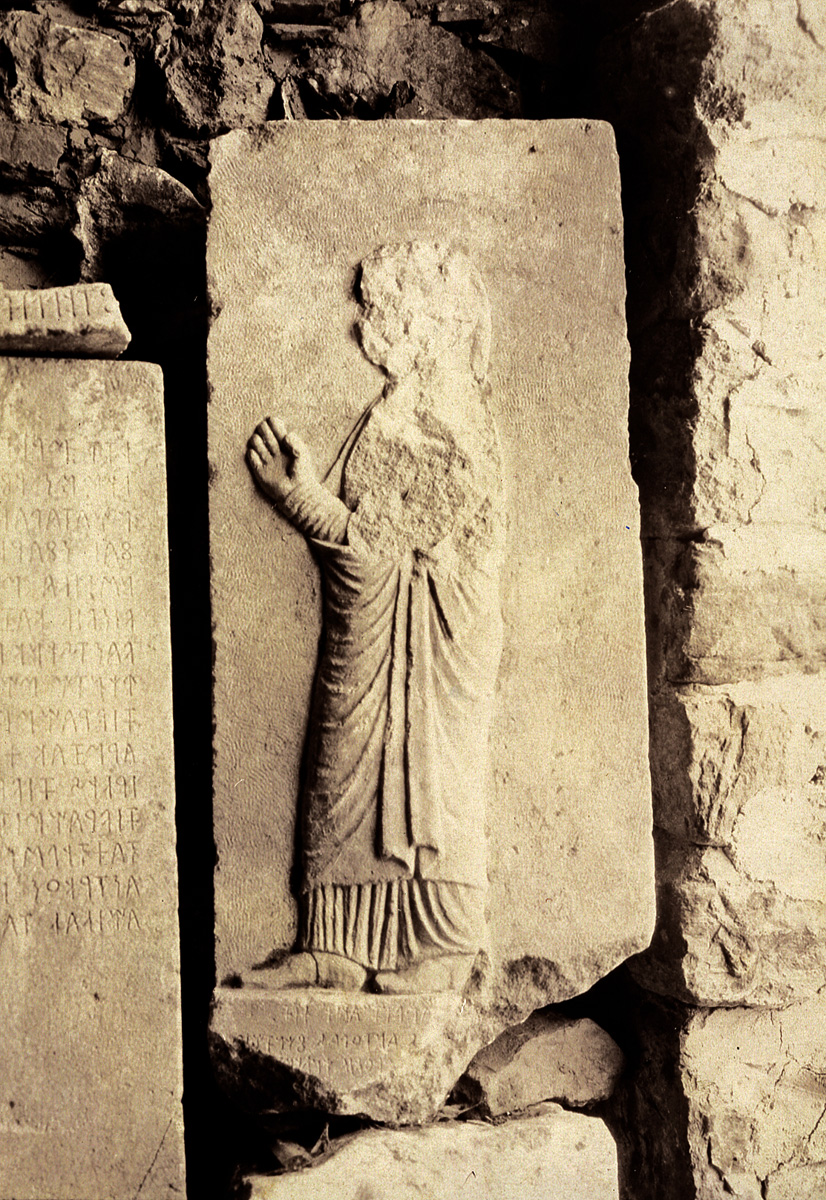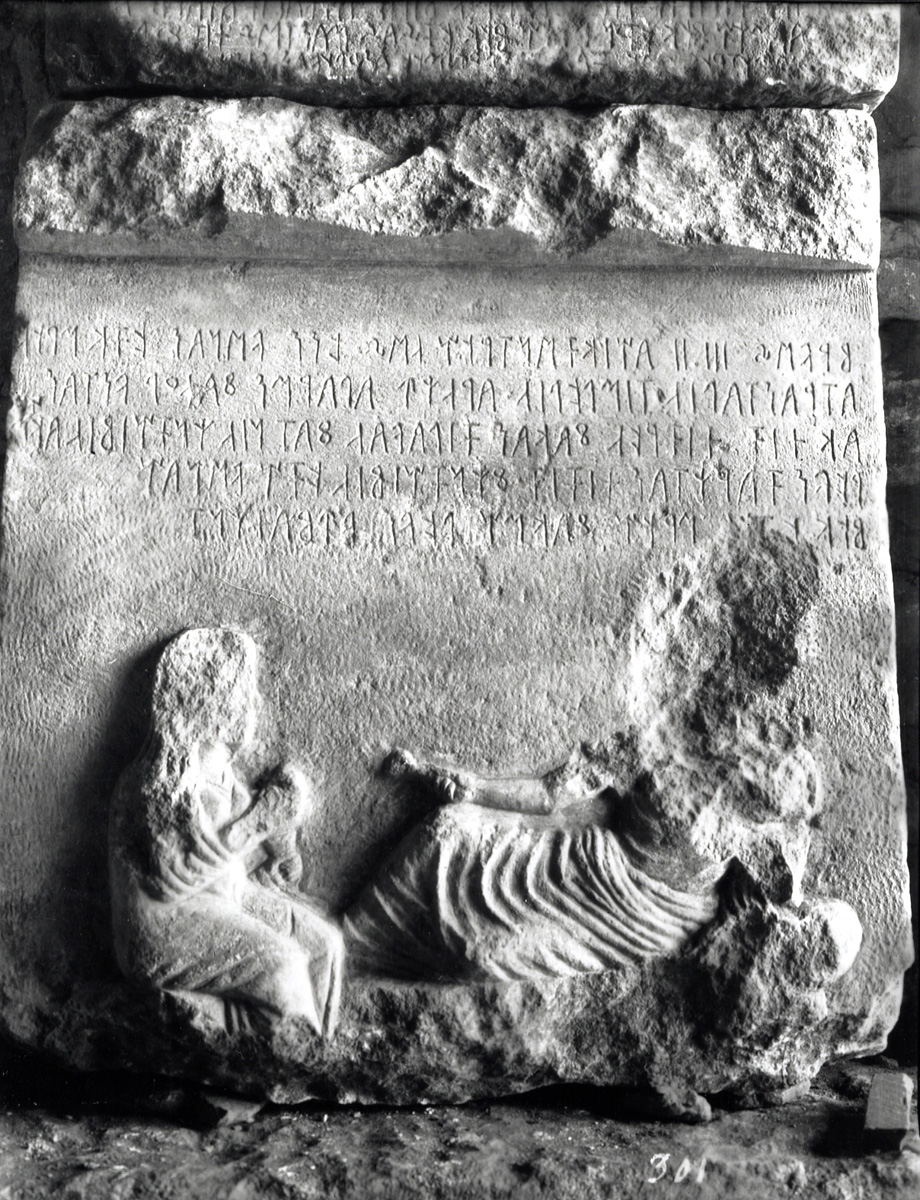-
 Marble Sculpture of a Walking Lion
Marble Sculpture of a Walking LionR2 Cat. 38
Sculpture
Marble, Stone
Ca. 350-330 BC (Late Lydian (Persian))
The large rounded muscles of the shoulders, body, and hind legs are shown in motion. The mane had a halo-like arrangement radiating around the face, then descending in a triangle over the chest. Upright head and entire chest were turned to his r. A b...
-
 Marble Sculpture of a Headless Recumbent Sphinx
Marble Sculpture of a Headless Recumbent SphinxR2 Cat. 41
Sculpture
Marble, Stone
Late 6th or 5th C. BC? (Late Lydian (Persian))
A straight rectangular cut was made to seat the neck, head, and part of the wing (rectangle: W. 0.19, L. 0.15; dowel hole: diam. 0.035, D. 0.035). Judging from the cutting, the head may have been slightly turned to the proper r. The tail is slung up ...
-
 Sphinx, Probably from a Throne
Sphinx, Probably from a ThroneR2 Cat. 42
Sculpture
Marble, Stone
4th or 3rd C. BC? (Late Lydian (Persian)?)
Unlike Cat. 41 (Figs. 142-143), this sphinx is made in one piece with the lower back part of the throne. The body is partly in the round (at the front and on top) and partly in relief and, unlike Cat. 41, the relief background extends under the body ...
-
 Marble Sculpture of a Woman with Archaistic Drapery
Marble Sculpture of a Woman with Archaistic DraperyR2 Cat. 55
Sculpture
Marble, Stone
(Hellenistic or Roman)
The woman stands with l. foot forward slightly, her weight on the r. leg. The overfold of the himation is attached at her r. shoulder, and hangs in diagonal folds to her upper thighs. The pattern is elaborated by two nearly symmetrical falls of drape...
-
 Marble Torso of an Artemis Priestess (?)
Marble Torso of an Artemis Priestess (?)R2 Cat. 62
Sculpture
Marble, Stone
1st Half of 2nd C. AD (Roman)
The figure wears an ungirt peplos with short sleeves; Hanfmann and Polatkan suggest (Three Sculptures, 65) that this may be a priestess of Artemis, although the dress is quite different from Moschine (Cat. 246, Figs. 426-427), the only known priestes...
-
 Marble Sculpture of the Lower Part of a Standing Woman
Marble Sculpture of the Lower Part of a Standing WomanR2 Cat. 65
Sculpture
Marble, Stone
2nd C. AD? (Roman)
The lower part of a heavy woolen cloak goes in a curving diagonal across the chiton, sweeping over the feet. The r. leg was drawn back, pulling the chiton with it. There are deep vertical drill runs in the chiton, whereas the himation has broad smoot...
-
 Marble Statue of the Torso of an Athlete
Marble Statue of the Torso of an AthleteR2 Cat. 74
Sculpture
Marble, Stone
Hadrianic (Roman)
The nude male had r. arm raised, holding a wide ribbon, the tasseled end of which is preserved on l. shoulder; hence an anadoumenos. The position of the neck shows the head was turned slightly to proper r. and forward. A trace of a rectangular strut ...
-
 Portrait of Sabina (?)
Portrait of Sabina (?)R2 Cat. 78
Sculpture
Marble, Stone
Ca. 120 AD? (Roman)
The portrait shows a lady wearing a diadem and a veil which hangs down on both sides of the head in several folds. The back of the veil is only very roughly worked, suggesting that the piece was intended for display against a wall.
The piece is mounte...
-
 Head of Zeus
Head of ZeusR2 Cat. 108
Sculpture
Marble, Stone
Antonine? (Roman?)
The hair is piled up in wreath-like coiffure above the forehead. The crown of the head is carved in flatter waves, encircled by a rounded and twisted fillet. Lower half of ears shows beneath hair, as on the Boston head from Mylasa. Loose strands fall...
-
 Fragmentary Statue Group of Dionysus, Panther, and Satyr
Fragmentary Statue Group of Dionysus, Panther, and SatyrR2 Cat. 121
Sculpture
Marble, Stone
2nd C. AD (Roman)
Dionysus, standing frontally, is accompanied at his r. by a recumbent panther and a satyr, whose feet only are preserved. A round broken stump in front of the l. foot of Dionysus suggests that he carried a thyrsus in his l. hand. His long hair falls ...
-
 Marble Sculpture of Asklepios
Marble Sculpture of AsklepiosR2 Cat. 125
Sculpture
Marble, Stone
Hadrianic (Roman)
Asklepios stands with weight on I. leg, r. leg bent, I. hand on hip. His head was turned slightly to proper r. He wears sandals with closed heels; a cloak falls over his I. shoulder, is drawn across both hips and held by I. hand, leaving most of tors...
-
 Altar with Bucrania and Garlands
Altar with Bucrania and GarlandsR2 Cat. 160
Sculpture
Marble, Stone
2nd C. AD? (Roman?)
The three bucrania of the cylindrical altar are tied to garlands with beaded ribbons vittae). Above the garlands are a moon, crescent, and star.
The dedicatory inscription mentions Noemon, priest of the Mother of the Gods.
The work is reasonably ca...
-
 Pilaster Capital with Gorgon Head
Pilaster Capital with Gorgon HeadR2 Cat. 195
Sculpture
Marble, Stone
2nd or 3rd C. AD (Roman)
A stylized Corinthian pilaster capital, this has unusually vertical and straight tendrils, one stem on each side breaking into two curved tendrils under the simple top profile. An acanthus leaf frames each side. In the center, between the tendrils, i...
-
 Block with Woman in Relief
Block with Woman in ReliefR2 Cat. 212
Sculpture
Marble, Stone
1st or 2nd C. AD (Roman)
A priestess, praying with raised arms, stands on the end of a block. She wears a peplos, belted beneath the breasts, and an extra piece of cloth hangs diagonally across her chest. The drapery clings to both legs and falls in three heavy folds, one at...
-
 Hekate
HekateR2 Cat. 263
Sculpture
Marble, Stone
2nd C. AD (Roman)
The three-headed Hekate has a common trunk and polos, and three arms. The faces are badly worn, but are flat, with prominent rounded chins. The hair, parted in the middle, falls in undifferentiated tresses to the shoulders. Breasts are clearly deline...
-
 Table Legs with Eagles in Relief
Table Legs with Eagles in ReliefR2 Cat. 217
Sculpture
Marble, Stone
Late Hellenistic or Early Imperial (Hellenistic or Roman)
A (at S end of table). An eagle, looking to proper r. and with wings outstretched, clutches thunderbolts with both claws. His large rounded chest (projecting 0.11 from background) and legs are covered with overlapping feathers. Upper wings have a sim...
-
 Rock-Cut Relief Aedicula with Two Frontal Figures
Rock-Cut Relief Aedicula with Two Frontal FiguresR2 Cat. 156
Sculpture
Marble, Stone
3rd-2nd C. BC (Hellenistic)
The architectural frame consists of a rather steeply pitched pediment outlined on the rock with rows of points. Underneath the pediment is a row of (originally 16?) rectangles alternately projecting and recessed; 8 raised and 4 recessed rectangles su...
-
 Fragment of Garland Frieze
Fragment of Garland FriezeR2 Cat. 168
Sculpture, Sarcophagus
Marble, Stone
Hellenistic or Early Roman (Hellenistic or Roman)
On the molding is a neat egg and dart; under it, a bull's head carrying a garland of leaves and fruit. A four-petalled rosette hangs over the garland. This is sketchy work, but the egg and dart, particularly, is done with a certain skill. If this is ...
-
 Frieze with Grazing Deer
Frieze with Grazing DeerR2 Cat. 230
Sculpture
Marble, Stone
600-550 BC (Lydian)
The square joints at the sides are preserved. The flat moulding is similar to but thinner than that above the relief on Cat. 231 (Fig. 401). In Cat. 230, it runs horizontally below the frieze as a ground line. The relief shows a row of three grazing ...
-
 Frieze of Horsemen
Frieze of HorsemenR2 Cat. 231
Sculpture
Marble, Stone
550-450 BC (Late Lydian (Persian))
The joint on the r. is square, that on the I. is beveled, with a plain vertical band in front indicating the end of the relief. There are two flat moldings along the top and bottom; the space above, below, and between is recessed; and the relief is i...
-
Relief with Head of Bearded Man
R2 Cat. 232
Sculpture
Marble, Stone
500-480 BC (Late Lydian (Persian))
The relief, which is probably from a funerary stele, was described by Richter, but renewed examination shows that the face is bearded and the nose big and elongated (cf. the bearded boxer, Richter, Archaic Gravestones, no. 31, fig. 92) The hairdo and...
-
 Stele with Praying Woman
Stele with Praying WomanR2 Cat. 233
Sculpture
Marble, Stone
450-425 BC (Late Lydian (Persian))
Although there is no sign of dowelling on top, the stele probably had a covering element, possibly a palmette. A female figure facing to I. is placed freely and somewhat asymmetrically on a claw-chiseled background. The sides of the stele are also cl...
-
 Funerary Stele of Atrastas, son of Timles
Funerary Stele of Atrastas, son of TimlesR2 Cat. 234
Sculpture
Marble, Stone
330-329 BC (Hellenistic)
C. H. Greenewalt, Jr. noted that at the top, the relief molding has painted egg and dart motif, yellow with black background. There are five lines of text in Lydian, with red preserved in some letters. Below the text is a sculptured scene showing a m...
-
 Relief with Funerary Meal
Relief with Funerary MealR2 Cat. 234bis
Sculpture
Marble, Stone
300 BC (Hellenistic)
The bearded man lies on a couch with a drinking cup in his I. hand. A snake coils over his l. shoulder and his veiled wife sits at his feet. Before him stands a three-legged table, beside it a wine jar and a small boy who is serving the wine. On the ...
-
Lion Sejant From Nannas Monument
R2 Cat. 235
Sculpture
Marble, Stone
Ca. 500 BC (Late Lydian (Persian))
The lion is seated in a frontal position. The tail loops under the hindquarters and over the left haunch. The mane has long wavy locks ending slightly down the back, less deeply cut than Synagogue lions (Cat. 25A, Cat. 25B Figs. 92-101). The style is...